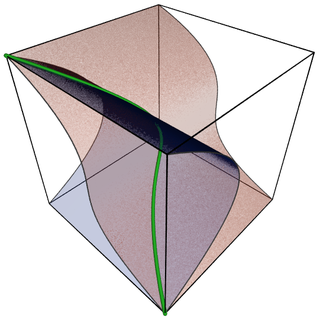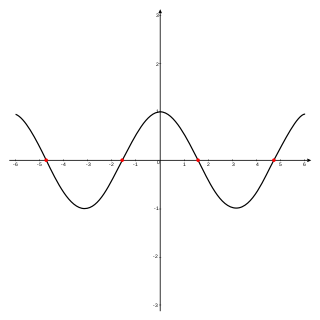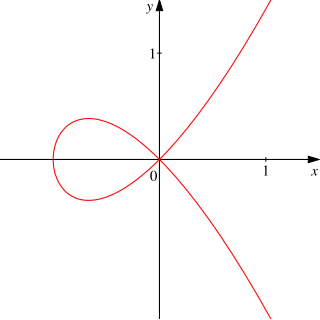
Algebraic geometry is a branch of mathematics, classically studying zeros of multivariate polynomials. Modern algebraic geometry is based on the use of abstract algebraic techniques, mainly from commutative algebra, for solving geometrical problems about these sets of zeros.
In mathematics, particularly in algebra, a field extension is a pair of fields such that the operations of E are those of F restricted to E. In this case, F is an extension field of E and E is a subfield of F. For example, under the usual notions of addition and multiplication, the complex numbers are an extension field of the real numbers; the real numbers are a subfield of the complex numbers.

In mathematics, specifically abstract algebra, an integral domain is a nonzero commutative ring in which the product of any two nonzero elements is nonzero. Integral domains are generalizations of the ring of integers and provide a natural setting for studying divisibility. In an integral domain, every nonzero element a has the cancellation property, that is, if a ≠ 0, an equality ab = ac implies b = c.

In ring theory, a branch of abstract algebra, a commutative ring is a ring in which the multiplication operation is commutative. The study of commutative rings is called commutative algebra. Complementarily, noncommutative algebra is the study of noncommutative rings where multiplication is not required to be commutative.
In mathematics, Hilbert's Nullstellensatz is a theorem that establishes a fundamental relationship between geometry and algebra. This relationship is the basis of algebraic geometry. It relates algebraic sets to ideals in polynomial rings over algebraically closed fields. This relationship was discovered by David Hilbert, who proved the Nullstellensatz and several other important related theorems named after him.
In mathematics, an irreducible polynomial is, roughly speaking, a polynomial that cannot be factored into the product of two non-constant polynomials. The property of irreducibility depends on the nature of the coefficients that are accepted for the possible factors, that is, the field to which the coefficients of the polynomial and its possible factors are supposed to belong. For example, the polynomial x2 − 2 is a polynomial with integer coefficients, but, as every integer is also a real number, it is also a polynomial with real coefficients. It is irreducible if it is considered as a polynomial with integer coefficients, but it factors as if it is considered as a polynomial with real coefficients. One says that the polynomial x2 − 2 is irreducible over the integers but not over the reals.

In algebraic geometry and commutative algebra, the Zariski topology is a topology which is primarily defined by its closed sets. It is very different from topologies which are commonly used in the real or complex analysis; in particular, it is not Hausdorff. This topology was introduced primarily by Oscar Zariski and later generalized for making the set of prime ideals of a commutative ring a topological space, called the spectrum of the ring.

Algebraic varieties are the central objects of study in algebraic geometry, a sub-field of mathematics. Classically, an algebraic variety is defined as the set of solutions of a system of polynomial equations over the real or complex numbers. Modern definitions generalize this concept in several different ways, while attempting to preserve the geometric intuition behind the original definition.
In ring theory, a branch of mathematics, the radical of an ideal of a commutative ring is another ideal defined by the property that an element is in the radical if and only if some power of is in . Taking the radical of an ideal is called radicalization. A radical ideal is an ideal that is equal to its radical. The radical of a primary ideal is a prime ideal.

In mathematics, an affine algebraic plane curve is the zero set of a polynomial in two variables. A projective algebraic plane curve is the zero set in a projective plane of a homogeneous polynomial in three variables. An affine algebraic plane curve can be completed in a projective algebraic plane curve by homogenizing its defining polynomial. Conversely, a projective algebraic plane curve of homogeneous equation h(x, y, t) = 0 can be restricted to the affine algebraic plane curve of equation h(x, y, 1) = 0. These two operations are each inverse to the other; therefore, the phrase algebraic plane curve is often used without specifying explicitly whether it is the affine or the projective case that is considered.

In mathematics, a zero of a real-, complex-, or generally vector-valued function , is a member of the domain of such that vanishes at ; that is, the function attains the value of 0 at , or equivalently, is the solution to the equation . A "zero" of a function is thus an input value that produces an output of 0.

In algebraic geometry, an affine variety, or affine algebraic variety, over an algebraically closed field k is the zero-locus in the affine space kn of some finite family of polynomials of n variables with coefficients in k that generate a prime ideal. If the condition of generating a prime ideal is removed, such a set is called an (affine) algebraic set. A Zariski open subvariety of an affine variety is called a quasi-affine variety.

In algebraic geometry, a projective variety over an algebraically closed field k is a subset of some projective n-space over k that is the zero-locus of some finite family of homogeneous polynomials of n + 1 variables with coefficients in k, that generate a prime ideal, the defining ideal of the variety. Equivalently, an algebraic variety is projective if it can be embedded as a Zariski closed subvariety of .

In mathematics, especially in the field of algebra, a polynomial ring or polynomial algebra is a ring formed from the set of polynomials in one or more indeterminates with coefficients in another ring, often a field.
In mathematics, an algebraic variety V in projective space is a complete intersection if the ideal of V is generated by exactly codim V elements. That is, if V has dimension m and lies in projective space Pn, there should exist n − m homogeneous polynomials:
In field theory, a branch of mathematics, the minimal polynomial of an element α of a field is, roughly speaking, the polynomial of lowest degree having coefficients in the field, such that α is a root of the polynomial. If the minimal polynomial of α exists, it is unique. The coefficient of the highest-degree term in the polynomial is required to be 1, and the type for the remaining coefficients could be integers, rational numbers, real numbers, or others.
In real algebraic geometry, Krivine–StenglePositivstellensatz characterizes polynomials that are positive on a semialgebraic set, which is defined by systems of inequalities of polynomials with real coefficients, or more generally, coefficients from any real closed field.

In mathematics, an algebraic number field is an extension field of the field of rational numbers such that the field extension has finite degree . Thus is a field that contains and has finite dimension when considered as a vector space over .
Projective space plays a central role in algebraic geometry. The aim of this article is to define the notion in terms of abstract algebraic geometry and to describe some basic uses of projective space.
In algebra, the ring of restricted power series is the subring of a formal power series ring that consists of power series whose coefficients approach zero as degree goes to infinity. Over a non-archimedean complete field, the ring is also called a Tate algebra. Quotient rings of the ring are used in the study of a formal algebraic space as well as rigid analysis, the latter over non-archimedean complete fields.











